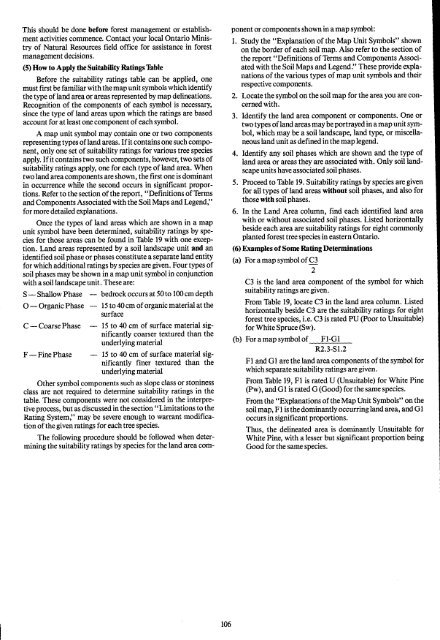The Soils of The Regional Municipality of Ottawa=Carleton
The Soils of The Regional Municipality of Ottawa=Carleton
The Soils of The Regional Municipality of Ottawa=Carleton
You also want an ePaper? Increase the reach of your titles
YUMPU automatically turns print PDFs into web optimized ePapers that Google loves.
This should be done before forest management or establishment<br />
activities commence. Contact your local Ontario Ministry<br />
<strong>of</strong> Natural Resources field <strong>of</strong>fice for assistance in forest<br />
management decisions.<br />
(5) How toApply the Suitability Ratings Table<br />
Before the suitability ratings table can be applied, one<br />
must firstbe familiar withthe mapunit symbols which identify<br />
the type <strong>of</strong> land area or areas represented by map delineations.<br />
Recognition <strong>of</strong> the components <strong>of</strong> each symbol is necessary,<br />
since the type <strong>of</strong> land areas upon which the ratings are based<br />
account for at least one component <strong>of</strong> each symbol .<br />
A map unit symbol may contain one or two components<br />
representing types <strong>of</strong>land areas . If it contains one such component,<br />
only one set <strong>of</strong> suitability ratings for various tree species<br />
apply. If itcontainstwo suchcomponents, however, two sets <strong>of</strong><br />
suitability ratings apply, one for each type <strong>of</strong> land area . When<br />
two land area components are shown, the first one is dominant<br />
in occurrence while the second occurs in significant proportions<br />
. Refer to the section <strong>of</strong>the report, "Definitions <strong>of</strong>Terms<br />
and Components Associated with the Soil Maps and Legend,"<br />
for more detailed explanations .<br />
Once the types <strong>of</strong> land areas which are shown in a map<br />
unit symbol have been determined, suitability ratings by species<br />
for those areas can be found in Table 19 with one excep<br />
tion . Land areas represented by a soil landscape unit and an<br />
identified soil phase or phases constitute a separate land entity<br />
for which additional ratings by species are given. Four types <strong>of</strong><br />
soil phases may be shown in a map unit symbol in conjunction<br />
with a soil landscape unit . <strong>The</strong>se are :<br />
S- Shallow Phase - bedrock occurs at 50 to 100 cm depth<br />
O-OrganicPhase -- 15 to 40 cm <strong>of</strong> organic material at the<br />
surface<br />
C-Coarse Phase - 15 to 40 cm <strong>of</strong> surface material significantly<br />
coarser textured than the<br />
underlying material<br />
F-Fine Phase - 15 to 40 cm <strong>of</strong> surface material significantly<br />
finer textured than the<br />
underlying material<br />
Other symbol components such as slope class or stoniness<br />
class are not required to determine suitability ratings in the<br />
table. <strong>The</strong>se components were not considered in the interpre<br />
tive process, but as discussed inthe section "Limitationsto the<br />
Rating System," may be severe enough to warrant modification<br />
<strong>of</strong>the givenratings for each tree species .<br />
<strong>The</strong> following procedure should be followed when determining<br />
the suitability ratings by species for the land area com-<br />
ponent or components shown in a map symbol :<br />
1 . Study the "Explanation <strong>of</strong>the Map Unit Symbols" shown<br />
on the border <strong>of</strong> each soil map. Also refer to the section <strong>of</strong><br />
the report "Definitions <strong>of</strong> Terms and Components Associated<br />
with the Soil Maps and Legend ." <strong>The</strong>se provide explanations<br />
<strong>of</strong> the various types <strong>of</strong> map unit symbols and their<br />
respective components .<br />
2 . Locate the symbol on the soil map for the area you are concerned<br />
with .<br />
3 . Identify the land area component or components . One or<br />
two types <strong>of</strong>land areas may be portrayed in amap unitsymbol,<br />
which may be a soil landscape, land type, or miscellaneous<br />
land unit as defined in the map legend .<br />
4 . Identify any soil phases which are shown and the type <strong>of</strong><br />
land area or areas they are associated with . Only soil landscapeunits<br />
have associated soil phases .<br />
5 . Proceed to Table 19 . Suitability ratings by species are given<br />
for all types <strong>of</strong> land areas without soil phases, and also for<br />
those with soil phases .<br />
6 . In the Land Area column, find each identified land area<br />
with or without associated soil phases . Listed horizontally<br />
beside each area are suitability ratings for eight commonly<br />
planted forest tree species in eastern Ontario .<br />
(6) Examples <strong>of</strong> Some Rating Determinations<br />
(a) For a map symbol <strong>of</strong> C3<br />
2<br />
C3 is the land area component <strong>of</strong> the symbol for which<br />
suitability ratings are given .<br />
From Table 19, locate C3 in the land area column . Listed<br />
horizontally beside C3 are the suitability ratings for eight<br />
forest tree species, i .e. C3 is rated PU (Poor to Unsuitable)<br />
for White Spruce (Sw) .<br />
For a map symbol <strong>of</strong> F1-Gl<br />
R2.3-S1 .2<br />
F1 and GI are the land area components <strong>of</strong>the symbol for<br />
which separate suitability ratings aregiven .<br />
From Table 19, F1 is rated U (Unsuitable) for White Pine<br />
(Pw), and G 1 is rated G (Good) forthe same species .<br />
From the "Explanations <strong>of</strong>the Map Unit Symbols" on the<br />
soil map, F 1 is the dominantly occurring land area, and G 1<br />
occurs in significant proportions.<br />
Thus, the delineated area is dominantly Unsuitable for<br />
White Pine, with a lesser but significant proportion being<br />
Good for the same species .

















